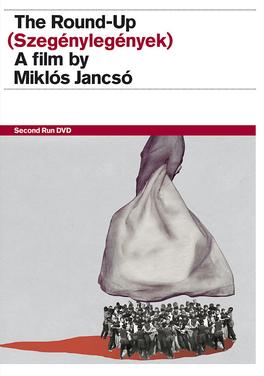The Round-Up
The Round-Up (Hungarian: Szegénylegények, "Poor young men", i. e. outlaws) is a 1966 Hungarian film directed by Miklós Jancsó. Well received in its home country, it was Jancsó's first film to receive international acclaim.
Today, many consider The Round-Up a classic of world cinema; it was selected to be screened in the Cannes Classics section of the 2015 Cannes Film Festival.
"The Round-Up" is an obscure Hungarian film critically-acclaimed for its stark, minimalist style and political overtones. In this grim, realistic drama set in 1868, Austro-Hungarian soldiers imprison a group of peasants and subject them to mental and physical torment to make them reveal information about an insurrectionist conspiracy.
Plot
Following the quelling of Lajos Kossuth's 1848 revolution against Habsburg rule in Hungary, prison camps were set up for people suspected of being Kossuth's supporters. Around 20 years later, some members of highwayman Sándor Rózsa's guerrilla band, believed to be some of Kossuth's last supporters, are known to be interned among the prisoners in a camp. The prison staff tries to identify the rebels and find out if Sándor is among them using various means of mental and physical torture and trickery. When one of the guerrillas, János Gajdar, is identified as a murderer by an old woman, he starts aiding his captors by acting as an informant. Gajdar is told that if he can show his captors a man who has killed more people than himself, he will be spared. Fearing for his life, he turns in several people his captors have been looking for by name but is unable to identify among the prisoners.
Eventually, Gajdar becomes an outcast among the prisoners and is murdered at night by some of his fellow inmates while in solitary confinement. The prison guards easily discover suspects, people whose cells had been left unlocked for the night, and start interrogating them with the hope of finding Sándor himself. The suspects are tricked into revealing the remaining guerrillas when they are given a chance to form a new military unit out of former bandits and informed that Sándor, who was not among the prisoners, has been pardoned. However, the celebrating guerrillas are then told that those who previously fought under him will still face execution.
This clip is the best-filmed example of "running the gauntlet", once a common form of military corporal punishment in the 19th Century. It was also practiced by some Indian tribes in North America. Here, director Miklos Jancso almost seems to be going for a bit of titillating exploitation by having such a beautiful young girl run naked between two lines of soldiers armed with switch-rods. However, it's filmed in a matter-of-fact manner.
Keywords: political; history; military; prison; army; hungary; corporal punishment; caning
Chat rooms • What links here • Copyright info • Contact information • Category:Root
